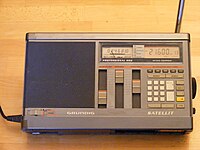
Photo from wikipedia
This study evaluates shipboard marine X-band radar (MR) near-surface current and bathymetry measurements under shallow water conditions. The retrieval algorithm is based on the surface wave signal within three-dimensional wave… Click to show full abstract
This study evaluates shipboard marine X-band radar (MR) near-surface current and bathymetry measurements under shallow water conditions. The retrieval algorithm is based on the surface wave signal within three-dimensional wave number frequency MR backscatter intensity variance spectra. The MR data were collected during a research cruise that investigated submesoscale processes and their impact on oil spill transport in the Louisiana Bight. The MR currents and bathymetry are validated using measurements from 500 GPS-equipped surface drifters, a shipboard acoustic Doppler current profiler, and a shipboard single-beam echo sounder. Earlier results from the same experiment but using a different set of sensors indicate strong upper ocean vertical current shear over a 3.5 hr period, despite only mild wind forcing. Here, the MR currents are derived as a function of wave number, providing a measure of vertical shear for the full duration of the cruise. Strong vertical shear is frequently observed, with a maximum difference of 0.42 m/s between the MR high (effective depth of ∼0.9 m) and low (∼2.4 m) wave number bins. Treating the drifter and echo sounder measurements as truth, the accuracies of the MR near-surface currents and bathymetry are 0.04–0.07 m/s and 1.2 m (or 7% of the mean water depth). However, it is shown that ∼50% of the MR high wave number and drifter current differences is due to vertical shear. The shallow water MR near-surface current accuracy thus matches findings from a previous deep water validation where vertical shear was much weaker.
Journal Title: Journal of Geophysical Research
Year Published: 2020
Link to full text (if available)
Share on Social Media: Sign Up to like & get
recommendations!